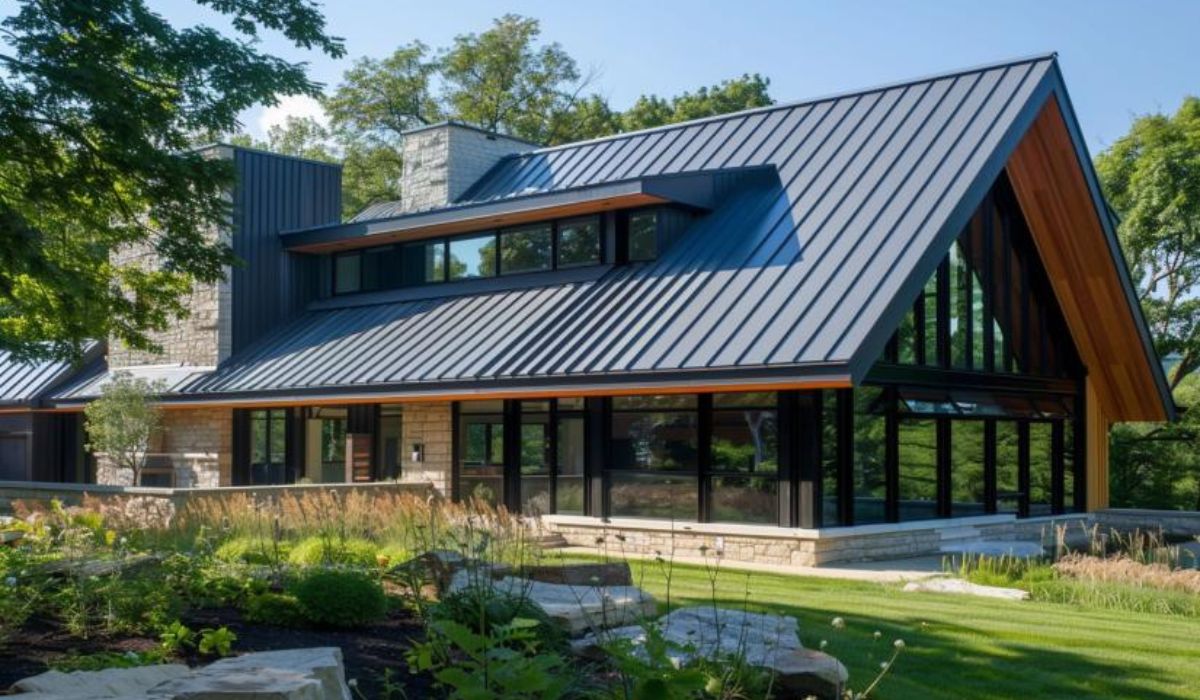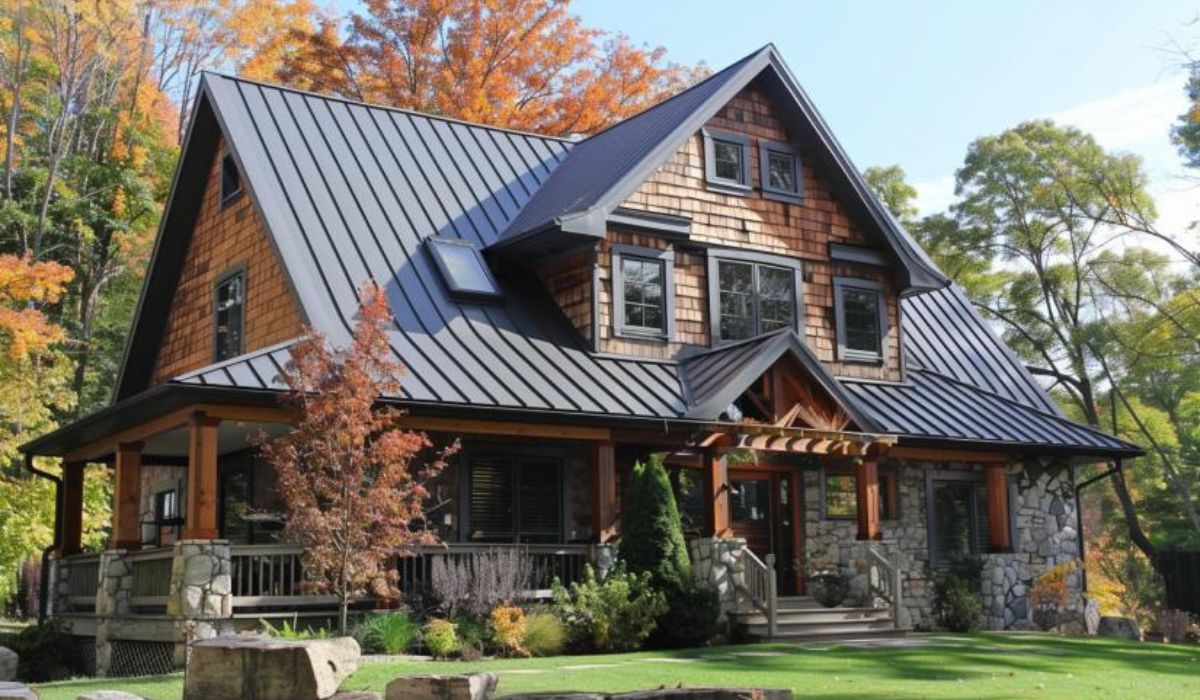
Are you considering getting a metal roof for your home? Do you know what components make up a metal roof? Understanding the essential parts of a metal roof is crucial for making informed decisions about its installation and maintenance. From the roof decking to the metal panels, each component plays a vital role in ensuring the durability and longevity of your roof system. So, let’s take a closer look at the different parts that come together to create a high-performance metal roof.
Key Takeaways:
- A metal roof is made up of several essential components that work together for a long-lasting roofing system.
- The parts of a metal roof include roof decking, lock strips, high-heat ice and water shield, metal panels, clips, Z bars, and ridge capping or transition metal.
- Understanding these components will help you make informed decisions about your metal roof installation and maintenance.
Roof Decking
Roof decking, also known as sheathing, is a critical component of a metal roof system. It serves as the sturdy foundation that supports and distributes the weight of the metal roof components. Typically made of plywood, OSB (oriented strand board), or plank boards, roof decking provides a solid base for the installation of the metal panels, lock strips, and other elements of the roof.
During a metal roof replacement, it is important to assess the condition of the roof decking. Any rotten or damaged decking should be replaced to ensure a stable and durable foundation for the new roof. By addressing any underlying issues with the decking, homeowners can ensure the long-term success of the metal roof replacement.
Proper installation of sturdy and reliable roof decking is crucial for the overall performance and longevity of the metal roof system. It provides structural support, helps maintain the shape and stability of the roof, and enhances its ability to withstand external factors such as wind, snow, and rain.
In addition to its functional role, roof decking also contributes to the energy efficiency and insulation properties of the roof. Depending on the type of material used, it can provide an extra layer of thermal protection, reducing heat transfer and enhancing the overall energy efficiency of the building.
Lock Strips
Lock strips play a crucial role in securing the metal roof panels and preventing them from lifting during strong winds. These strips are installed at the eaves and rakes of the roof, providing a secure connection between the panels and the underlying structure. By effectively locking the panels in place, lock strips ensure the stability and durability of the entire metal roof system.
One important aspect of lock strips is their color and gauge. They are typically designed to match the color and gauge of the metal roof panels, creating a seamless and aesthetically pleasing appearance. This attention to detail ensures that the lock strips blend in with the overall design of the roof, enhancing its visual appeal.
In addition to their structural function, lock strips are also coated with a Kynar 500 painted finish. This finish not only provides an added layer of protection against the elements but also helps maintain the color and visual integrity of the roof over time. The Kynar 500 painted finish is known for its exceptional durability and resistance to fading, ensuring that the metal roof retains its vibrant appearance for years to come.
High-Heat Ice and Water Shield as Underlayment

The underlayment of a metal roof serves as an additional layer of protection against moisture. For a metal roof, the underlayment is typically a high-heat ice and water shield. It is installed over the lock strips at the eaves and acts as a last line of defense for the roof decking.
This specialized underlayment is designed to withstand high temperatures and provide superior waterproofing. It is made from a combination of rubberized asphalt and a reflective surface, which helps to reduce heat absorption and prevent damage to the roof structure.
Proper installation of the underlayment is crucial to ensure its effectiveness. It should be applied in overlapping layers, starting from the bottom of the roof and working upwards. This ensures that any water or ice that may penetrate the metal panels will be directed away from the roof decking, preventing condensation and potential damage.
“The high-heat ice and water shield is an essential component of a metal roof system. It provides an added layer of protection against moisture, preventing potential damage to the roof decking.”
Metal Panels
Metal panels are a vital component of a metal roof system, forming the majority of the roof’s surface. These panels are securely attached to the roof decking using lock strips and clips, ensuring stability and durability.
The most common type of metal panels used in roofing is standing seam metal panels. These panels are specially designed without nail or fastener holes, enhancing their strength and minimizing the risk of leaks. Standing seam panels feature raised ribs or standing seams that allow them to expand and contract with temperature changes, ensuring the roof’s integrity throughout various weather conditions.
Metal panels come in a variety of gauges, which refers to the thickness of the metal. The gauge chosen depends on the desired level of strength and durability for the specific roofing project. Additionally, metal panels are available in a wide range of colors, accommodating different aesthetic preferences and architectural styles.
Overall, metal panels play a crucial role in not only protecting the roof but also enhancing the visual appeal of the building. With their strength, versatility, and aesthetic options, metal panels are a popular choice for both residential and commercial roofing projects.
Clips
Clips are a crucial component when it comes to securing metal roof panels together. These fasteners are installed at regular intervals along the vertical part of the panel and play a vital role in maintaining the stability of the entire metal roof system. Using metal roof clips ensures that the panels are securely fastened and prevents potential damage from wind uplift.
During installation, panel clips are screwed in place using gimlet screws, creating a solid connection between the panels. The use of these clips allows the panels to move naturally without wearing out the underlayment, providing flexibility to accommodate thermal expansion and contraction. This is especially important in areas with temperature variations.
By utilizing panel clips, homeowners can have peace of mind knowing that their metal roof will remain intact and continue to protect their home for years to come. The clips act as a reliable fastening method, ensuring the panels stay in place and maintain their structural integrity, even during severe weather events.
Z Bar and Ridge Capping/Transition Metal
When it comes to metal roofs, ensuring a watertight seal and protecting against water infiltration is crucial. That’s where the Z bar, ridge capping, and transition metal come into play.
The Z bar is a piece of metal flashing that fills in the gaps between the ribs of the metal panels and the ridge. This ensures that water cannot seep through those gaps and compromise the integrity of the roof. By properly installing the Z bar, homeowners can have peace of mind knowing their metal roof is well-protected.
Ridge capping is another essential component of a metal roof. It is installed at the peak where two slopes of the roof meet. Not only does ridge capping provide a finished look to the roof, but it also ensures a watertight seal. By keeping water out and preventing leaks, ridge capping adds an extra layer of protection to the roof structure.
Transition metal comes into play when the metal panels transition from a low slope roof to a steeper slope. Instead of using ridge capping, transition metal is used to create a smooth and straight plane. This helps maintain the integrity of the roof while ensuring proper water drainage.
Protecting Against Metal Roof Gaps
One of the main reasons why Z bar, ridge capping, and transition metal are important is to protect against metal roof gaps. These gaps can occur between the ridge and the metal panels, potentially allowing water to infiltrate the roof system. By using these components, homeowners can safeguard their metal roofs against water damage and ensure the longevity of their investment.
Understanding the importance of Z bar, ridge capping, and transition metal is essential for homeowners who have or are considering a metal roof. These components not only provide structural integrity but also protect against common vulnerabilities. Whether it’s filling in gaps or ensuring a watertight seal, Z bar, ridge capping, and transition metal play a vital role in the long-term performance and durability of a metal roof.
Conclusion
A metal roof system is a reliable and long-lasting choice for homeowners looking to protect their homes with a durable roofing solution. The various components, from roof decking to metal panels, work together to ensure the integrity and performance of the roof. Understanding these parts is essential for homeowners considering a metal roof installation or maintenance.
One of the major benefits of a metal roof system is its durability. Metal roofs are designed to withstand harsh weather conditions, such as strong winds, heavy rain, and snow. With proper installation and maintenance, a metal roof can last for decades, providing long-term protection for your home.
In addition to durability, metal roofs offer other advantages. They are low-maintenance, requiring minimal upkeep compared to other roofing materials. Metal roofs are also energy-efficient, reflecting sunlight and reducing heat transfer, which can help lower energy costs. Furthermore, metal roofs come in a wide range of colors and styles, offering homeowners versatility and aesthetic appeal.
When considering a metal roof installation, it is important to choose the right components and ensure proper installation. Consulting with a professional roofing contractor who specializes in metal roofs is recommended to ensure a seamless and reliable installation. By investing in a metal roof system, homeowners can enjoy the many benefits it offers, including durability, longevity, and aesthetic appeal.
Source Links
- https://www.bridgersteel.com/blog/components-of-a-metal-roof
- https://mydividedsky.com/the-7-parts-of-metal-roofing-and-what-they-do/
- https://www.billraganroofing.com/blog/main-metal-roof-parts

Meet William Adams, a seasoned roofing expert with over 30 years of hands-on experience in the industry. Having worked tirelessly under the scorching sun and through the fiercest storms, William brings a wealth of knowledge and expertise to the table. Hailing from the heart of the USA, he’s witnessed the evolution of roofing practices firsthand, mastering every aspect along the way. Now retired from the field, William spends his days cherishing time with his loved ones while sharing his invaluable insights through this platform. With William at the helm, you can trust that every tip, advice, and recommendation provided is backed by years of real-world experience and unwavering dedication to quality craftsmanship. Join us as we journey through the world of roofing, guided by the wisdom and passion of a true industry veteran.
